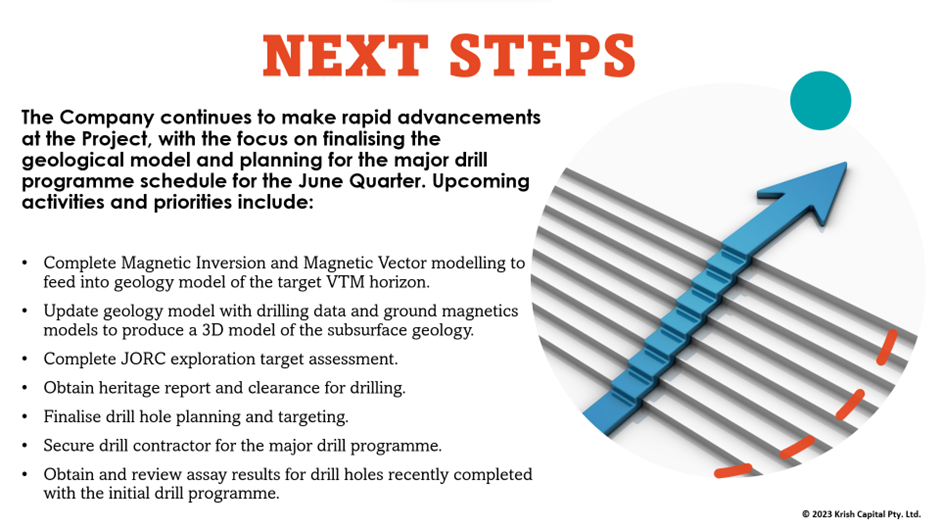Highlights
- Viking Mines (ASX:VKA) has wrapped up ~16km2 ground magnetics survey across the Canegrass Battery Minerals Project.
- The initial processing of ground magnetics geophysical data has also been done.
- As per the company release, the analytical signal supports mapping observation of Vanadiferous Titanomagnetite (VTM) mineralisation continuing South of Fold Nose Mineral Resource.
- The company is investigating magnetic inversion modelling as well as magnetic vector modelling to aid subsurface definition of the VTM for drill targeting.
ASX-listed battery metals explorer Viking Mines Limited (ASX:VKA) today shared that a ~16km2 ground magnetics survey has been completed across the Canegrass Battery Minerals Project, Western Australia.
The survey was conducted to increase the resolution of the geophysical data, mark high priority drill targets and interpret the VTM horizon. The data obtained during the survey has been shared with Terra Resources geophysical consultants for evaluation.
According to the company, initial processing is done, and few major observations have been made. This has ascended the priority of targets ahead of drilling scheduled for the June quarter.

According to the firm, from the ground magnetics survey, the identification of the strong analytical signal of particular significance as it is mapping the magnetite at surface to the South of the Fold Nose deposit, where a magnetic low occurs and as such not previously targeted for Vanadium.
Julian Woodcock commented, “This opens up the possibility for additional VTM mineralisation across the Project, which has not previously been recognised due to a geophysical characteristic called remnant magnetism. With the observations made, we have grown our confidence in the targets and look forward to moving forward with the next round of data processing and modelling ahead of our major drill programme planned for later in the June quarter.”
More on Ground Magnetics Survey process
Viking Mines has involved Terra Resources for processing and modelling the ground magnetics data as collected by Planetary Geophysics earlier this year.
As of now, the data has been through an initial review, cleaning as well as processing so as to obtain a composite image reflecting the magnetic features of the geology at the Canegrass Project.
The company believes there have been significant improvements in the resolution of the data as compared to the earlier airborne data to the ground magnetics data. VKA has attributed these improvements to the higher sampling frequency occurring along the lines walked during the data collection and the magnetic sensor being closer to the ground, as opposed to the older open-source data, which was collected using an airborne survey flying ~20m above the surface.
With the sensor at a lesser distance from the surface and thus, closer to the source of the magnetic signal, much more discrete features get mapped. These features are later used for interpreting the geology and defining the geological model.
Understanding analytical signal & remnant magnetism
As requested by Viking Mines, Terra Resources centered its focus on an area to the South of the Fold Nose Mineral Resource (59Mt at 0.66% V2O5). This was primarily because of a field observation at the Project during mapping in December 2022.
During mapping, several outcrops of VTM mineralisation were identified which delivered numerous high-grade rock chip results up to 1.40% V2O5.
The company has further revealed that the strong magnetic properties of the VTM mineralisation are present in the analytical signal image when data was further evaluated and processed.
This observation in the magnetic low on the geophysical image has led to the interpretation that parts of the Canegrass VTM mineralisation are showing remnant magnetism. It is understood that the change in orientation due to folding of the rocks occurring after their formation means they now show as a magnetic low as their magnetic field is being eliminated by the current orientation of the earth’s magnetic field.
Also, there is a strong consistent analytical signal observed at the Fold Nose North Extension target. A substantial extension to the Mineral Resource may be achieved through this area, asserts Viking Mines.
This area is included in the planned drilling programme to grow the Mineral Resource and importantly target higher grade intersections, which will upgrade the overall average grade of the Mineral Resource. Also, the use of magnetic signal strength as a proxy for magnetite volume lifts up the prospectivity of this target to outline significant high-grade VTM mineralisation.
Magnetic Inversion Modelling and Magnetic Vector Modelling
Currently, Terra Resources are looking at the ways to model the magnetic characteristics of the VTM mineralisation utilising Magnetic Inversion and Magnetic Vector modelling procedures. To overcome the remnant magnetism that has been detected south of the Fold Nose deposit, both techniques need to be considered.
For a subsurface 3D model of the magnetic susceptibility of the rock, such modelling techniques will be used. It will help in drill targeting as it will analyse the VTM mineralisation depth and potentially offer indications as to the volumes which can be present.

VKA shares were spotted trading at AU$0.011 in the early hours of 05 April 2023.






